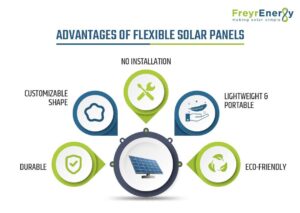The widespread use of renewable energy sources, such as solar, is becoming increasingly prevalent not just for residential purposes but also for commercial activities. Having said that, the technology behind solar panels has been consistently evolving, which has opened up a wider range of use cases for these setups across various other devices. Flexible Solar Panels are one of the incredible innovations that fit into several use cases where a conventional panel might not be ergonomically suitable.
Let us explore flexible solar panels further, including their types, advantages, and various use cases.
Advantages of Flexible Solar Panels
Bendable solar panel have a wide range of use cases, and they can be tailored to fit the shape or platform of a customer’s choice. As the name suggests, these flexible PV panels are used on various surfaces, in different locations, and for a range of outdoor applications. Here are some notable advantages that come along with:

- Customizable in any shape and size: The term ‘flexible’ is justified by these thin panels, which are easily bendable and can be fitted into any platform/device, or structure. Moreover, when considering size factors, flexible solar panels are typically lightweight and can be carried with ease anywhere.
- Excellent durability: These panels are designed to withstand and perform in almost all possible weather conditions. These panels are stable and provide a great supporting system.
- No separate installations: Flex solar panels require no installation, unlike on-grid or off-grid variants. These are significantly smaller in size and offer efficient power generation performance.
- Eco-friendly alternative: Last but not least, as a solar panel are efficient and allow you to avail of a non-polluting power alternative, even in portable means.
Types of Flexible Solar Panels Available
Flexible solar panels are available in 3 most common types, which include:
- Amorphous Silicon: Amorphous Silicon, or a-Si, panels are one of the most commonly found types of flexible panels. These panels are made by adding thin layers of silicon to a stable layer of stainless steel. The panels are ideally suited for their affordability and the efficiency levels they offer in low-light conditions. These panels are ideal for use in the early morning or late evening.
- Cadmium Tellurium: Also known as CdTe, this material is formed by combining two metals, Cadmium and Tellurium. The efficiency and lesser dependence on carbon dioxide are better than those of silicon. One of the most significant advantages of these metal combos is the ability to recycle. The product delivers greater efficiency at a reasonable price, performing well in low-light conditions as well.
- Copper Indium Gallium Selenide (CIGS ): These panels are backed by superior absorption efficiency, making them ideal for low-light usage. The efficiency range is far better than aSI variants and is extensively used in portable devices that are often powered with solar panel sheets. Thanks to its low-weight potential, this is usually preferred in portable vehicles and even outdoor camps for easy mobility.
Where to Use Flexible Solar Power?
Flexible sun panels have a vast number of use cases and applications that range from fitting into a portable van to being used in space missions (like what Vikram Lander used to power during the Chandrayaan mission). Let us list the common uses of these panels and how it has transformed lives:
While travelling (portable)
Adventure and travel enthusiasts can use flexible photovoltaic panels while camping or as an emergency backup in EV vehicles. Users can charge their mobile phones, power banks and even use a portable kettle. These panels are ideal for use in areas without a regular grid power supply. The reliability of these applications is remarkable for the generation.
Emergency Services
During times of a weather crisis, power grid failures, and calamities, a flexible solar panel is a proper SOS solution. These can be used by rescue teams and even households to generate a small backup power supply. Unlike a regular panel, these are easily deployable and can provide basic lighting and emergency services.
On-Grid & Off-Grid Solar Devices
The versatility of flexible solar panels lies in their ability to be used as a full-time off-grid setup. Unlike a full-fledged system, these flexible panels can only be used to power specific appliances and setups, such as water pumps and solar lanterns. The setup, when connected to batteries, can serve as an alternative source of energy and be used in the dark.
Final Thoughts
Flexible photovoltaic panels are gaining larger attention from the masses due to their flexibility and portable size. The leverage it offers for new users is incredible and efficient for its size. As technology improves, we may see newer panel forms emerge to provide a larger pool of flexible panels in the coming years.
